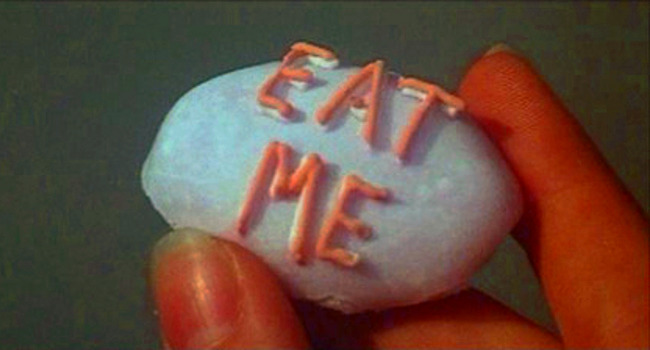Another recent viewing of random programs on Nashville’s over-the-air digital television paid off this past Saturday night when my girlfriend and I discovered this mind-blowing trip of a flick based on Lewis Carroll’s books. Alice’s Adventures in Wonderland is a 1972 British musical that features a great cast in a psychedelic journey that makes Tim Burton’s Alice seem calm, orderly and decidedly un-scary. This version finds Peter Sellers playing the March Hare, Dudley Moore as the humble Dormouse and future Bond Girl Fiona Fullerton in the title role.
Fullerton is especially good in her reading of Alice as a sassy redhead who never seems to do as she’s told. Here’s an entry from George’s Journal discussing the popularity of Alice’s story in the psychedelic age:
And, when you get down to it, it’s really no surprise the young and the hip of the ’60s (whether artists or their followers) found Alice’s adventures so psychedelic, surreal and, well, druggy. I mean, not only do they contain anthropomorphic characters ranging from the seemingly over-stimulated (Hatter) to the seemingly sleepily stoned (The Dormouse) and from the paranoid (The White Rabbit) to the actually visually ambiguous (The Cheshire Cat), one of them is even smoking a hookah-pipe (the always chilled out Caterpillar). Quite frankly, all of them seem to be tripping…
Associations of Alice with drug culture were to be seen everywhere at the time. While the ‘Disneyfied’ image of The Cheshire Cat was a constant on LSD blotters, Alice herself actually tripping was alluded to in a black-and-white, feature-length Alice In Wonderland adaptation, directed by former Beyond The Fringe member Jonathan Miller and broadcast by the BBC on December 28 1966 (see video above). Typical family fare for Christmas this was not, as the ‘Eat me’/ ‘Drink me’ sequence in which Alice grows larger and smaller was treated as if her activities were inducing her into a drugged state. No question, this version is a dark take on Dodgson’s work; Miller decided to film the animal characters as human characters, believing the story to be a cypher for a girl’s fears about the grown-up world around her: “Once you take the animal heads off, you begin to see what it’s all about. A small child, surrounded by hurrying, worried people, thinking ‘Is that what being grown-up is like?”…
Inspiration by, adaptation of and reference to Alice’s adventures didn’t end in the ’60s, though. Like it or not, they’ve been a veritable constant of modern culture. As soon as the early ’70s, Dodgson’s books were once again mined as the source for a major family film in the shape of Alice In Wonderland (1972). British-made, thoroughly charming and fondly recalled, this movie musical boasts future Bond Girl Fiona Fullerton as the heroine…and the cream of British acting talent, such as Ralph Richardson, Robert Helpmann, Michael Hordern and Spike Milligan, among others…
I found the entire film on the Curiouser and Curiouser YouTube channel which is an amazing repository of film and television versions of all things Alice. Here’s the flick…
Stay Awake!
Please subscribe to my YouTube channel where I archive all of the videos I curate at Insomnia. Click here to check out more Cinema posts.









